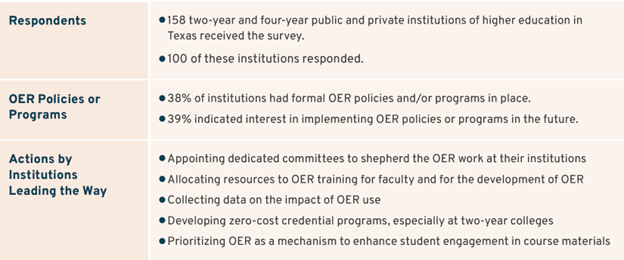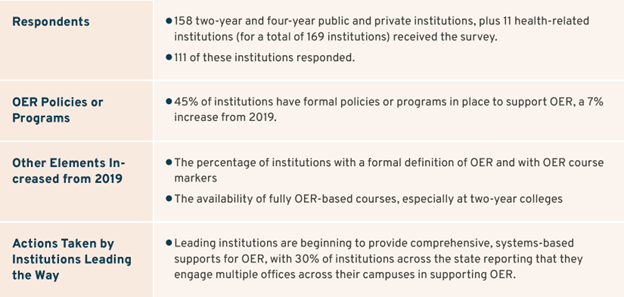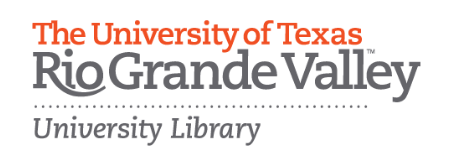Landscape Studies & Other Research on OER in Texas
In 2019, the Digital Higher Education Consortium of Texas (DigiTex) partnered with the THECB and the Institute for the Study of Knowledge Management in Education (ISKME) to begin conducting a biennial survey to examine the landscape of OER programs, policies, and practices at public and private nonprofit institutions in Texas.
2019 OER Survey & Landscape Analysis Selected Findings

The subsequent report, “Open Educational Resources (OER) in Texas Higher Education 2019,” paints a clear picture of expanding OER use and adoption in Texas.
In 2021, DigiTex, the THECB, and ISKME again partnered on the landscape survey, the results of which were released in “Advancing an Ecosystem for Open Educational Resources: OER in Texas Higher Education, Biennial Report 2021.” Building on data from the first survey, the second iteration of this survey showed continued growth in commitment to OER across the state.
2021 OER Survey & Landscape Analysis Selected Findings and Comparisons to 2019

Gap Analysis
In 2022, in collaboration with the THECB, ISKME conducted an analysis of gaps in OER for 25 highly transferable courses and core prerequisite courses for high-wage, high-demand fields, with an emphasis on courses commonly required across high-wage, high-demand workforce and career and technical education degree paths. The results were published in the final report, “ A Scan of Open Educational Resources (OER) Materials in High-Impact Higher Education Courses in Texas.” The analysis identified full courses and textbooks, with specific attention to elements identified as important for faculty adoption, such as inclusion of ancillary resources, presence of peer reviews, and recency of the course or textbook. ISKME collected information about full courses and textbooks, their relevant metadata, and the repository location for course-related OER. ISKME synthesized findings into a report that outlines where the greatest coverage and gaps lie for the priority courses and conducted a preliminary quality assessment regarding the level of effort required to use the identified OER content for Texas course development.
The gap analysis found that only one of the 25 high-priority courses had an OER course available that was clearly marked as peer reviewed, had been published in the last five years, and had three or more ancillaries. This course was not customized to Texas. However, 17 of the 25 high-priority courses had an OER course available that was updated in the last five years and had three or more ancillaries but was not peer reviewed, and six of these 17 had an OER course customized for Texas. Additionally, according to the findings, the number of priority courses that have a recent OER course with three or more ancillaries available (of 25) include:
- Peer-Reviewed: 1
- Not Peer-Reviewed: 17
- Texas-Aligned (no peer review): 6
This finding highlights challenges with establishing peer review in OER materials. This scan also surfaced other challenges with OER metadata that make quality assessment challenging, for instance, that a quarter of all OER courses lacked a copyright date or date of last update. A surprising finding was the low percentage of science OER courses that came with aligned labs. The gap analysis supports THECB and Texas institutions in identifying where future course development efforts should be directed.
Regional Analysis
Also in collaboration with the THECB, ISKME conducted a regional analysis, “Texas Open Educational Resources (OER) Regional Needs Analysis”, to assist in determining the needs of institutions that, according to the 2019 and 2021 OER landscape survey data, reported minimal OER commitment, engagement, and use. Analysis of the data identified three low-implementation subgroups based on interest in or progress towards institutional OER policies, programs, and initiatives: laggards, interested, and beginners. These groups shared the need for funding, professional development, dedicated OER staff, and access to OER in different disciplines and at different levels. They also shared the challenges of OER quality assurance, lack of administrative support, and lack of faculty awareness and buy-in.
Researchers mapped the identified institutions – as well as those that did not participate in the survey – by geolocation and by level of OER commitment to determine if specific regions of the state have greater need for OER support. Mapping indicated diverse OER implementation throughout Texas, with every region having more low-implementation than high-implementation institutions. Mapping also showed that 60% of OER landscape survey nonrespondents were private institutions. The regional analysis will help THECB improve the effectiveness and marketing of its open education initiatives, including professional development, funding, networking and mentoring opportunities, and support in identifying or creating peer-reviewed OER.

Key OER Milestones in Texas Infographic Transcript
1999-2007: Founding of OpenStax and COERLL
2011-2016: TACCCT and ATD Grant/Initiatives
2017-2021: Texas OER legislation passed and Biennial Landscape Analyses conducted; Creation of OERTX Repository
2022: Gap and Regional OER Analyses conducted; creation of Texas OER Playbook
What’s next?

